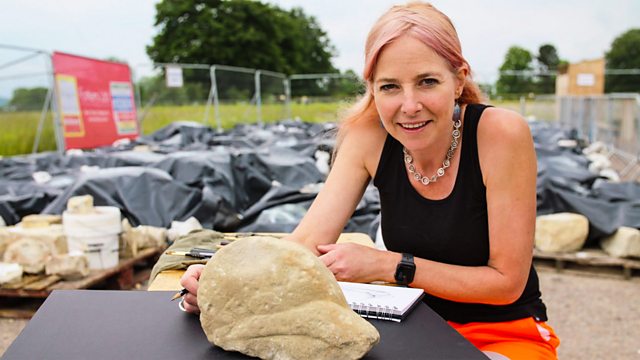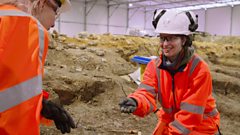
Episode 2
The south of England offers rich pickings, including the earliest money made in Britain and a massive haul of Roman treasure that brings to life the fall of the empire in Britain.
The south of England is the location for a rich and colourful selection of outstanding archaeology excavated in this episode.
The HS2 High Speed Rail line from London to Birmingham has kept archaeologists busy for several years, but few sites have been as puzzling as the ruin of a Norman church just outside Stoke Mandeville. Known to date to 1080, the structure and over 300 skeletons had to be completely removed, and in doing so astonishing discoveries were made underneath. Alice Roberts visited the site and speculated that some of the stonework found could possibly be Roman. A few weeks later she was proved spectacularly right! Archaeology was breaking national news as, over just a few days, a haul of three lifesize Roman busts, eight burial urns and an exquisite glass vessel were recovered from the bottom of a ring ditch. Alongside these artefacts was a remarkable skeleton, minus its head but complete with coins, which could reveal almost exactly when all these items were violently tossed into the ditch and covered over. Was it the moment the Romans relinquished control in Britain 1600 years ago?
On Salisbury Plain, a mysterious set of post holes has experts scratching their heads. If these were 3000-year-old Neolithic houses, what shape were these Bronze Age buildings, and what were the walls made of? Stuart Prior visits Butser farm, where experiments are under way to test various theories about how the walls of these important dwellings were made.
Alice visits another outstanding site of Roman archaeology at Silchester, where a bath complex is being excavated. The experience of Mike Fulford means he has been able to pinpoint layers in the building that reflect the rise and fall of Roman power in Britain. Mike brings his best finds to the Tent Studio, where Alice learns what the occupants of Silchester got up to in their bathhouse complex. Among the finds are gaming pieces, bone dice and a stunningly ornate Roman belt buckle.
On the banks of the river Thames in west London, a dig has revealed what is possibly the earliest known settlement ever uncovered in London. The archaeologists have also found what are thought to be some of the oldest coins ever made in Britain, possibly minted right there in Barn Elms in the Iron Age.
Finally, on the seabed of the Solent, near the Isle of Wight, lies the site of what was a Mesolithic settlement. This was dry land 10,000 years ago; now marine archaeologists have taken a sample of the soil for DNA testing. At the lab, expert investigator Cat Jarman follows the process that allows scientists to determine what was being grown and eaten by the Mesolithic people. The appearance of wheat, 2000 years earlier than previously accepted, is a major revelation.
Last on
More episodes
Previous
Next
Clip
-
![]()
脝thelred the Unready's coin
Duration: 01:49
Credits
| Role | Contributor |
|---|---|
| Presenter | Alice Roberts |
| Executive Producer | Edward Hart |
| Executive Producer | Rory Wheeler |
| Series Producer | Theo Williams |
| Production Company | Rare TV |


